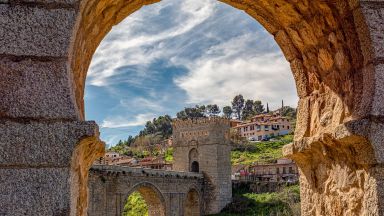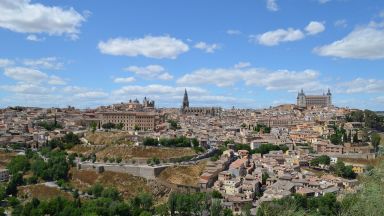Self Guided Walking Tour of Toledo (with maps!)
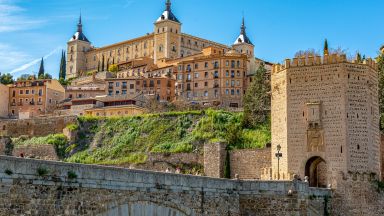
This website uses affiliate links which earn a small commission at no additional cost to you.
Toledo is the heart and soul of Spain and an incredibly cultural city. It has seen numerous cultures and dynasties pass through its walls, as well as wars, royalty and artists. The legacy it guards is an essential part of Spanish culture, so visiting the city is bound to be a unique experience. This monumental walled hilltop city is a captivating UNESCO World Heritage Site. Behind its daunting medieval walls, in a labyrinth of winding pedestrian streets, are some of the most important historical landmarks in the country.
Magnificent old stone buildings and quiet cobblestone streets whisper the legacy of the past. For centuries, Christians, Jews, and Muslims flourished in a “city of three cultures” and built a dazzling array of churches, convents, palaces, fortresses, synagogues, and mosques.
1. Puerta Nueva de Bisagra
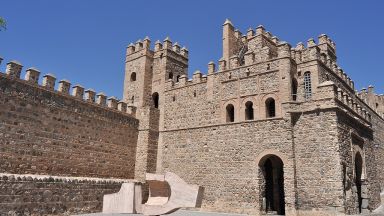
The Puerta Nueva de Bisagra is of Arab origin, and was rebuilt by Alonso de Covarrubias in Renaissance-style, back in the 16th century. It is one of Toledo’s six medieval city gates.
The side that faces the city opens up with a semi-circular arch, flanked by two square towers with roofs and decorated with the coat of arms of Charles I. The other side has an arch that bears the city’s coat of arms. This arch is flanked by two huge circular towers.
Across the road is the Tourist Information office.
Location: Puerta de Bisagra C. Real del Arrabal, 26 45003 Toledo Spain
Read more about Puerta de Bisagra
2. Puerta del sol
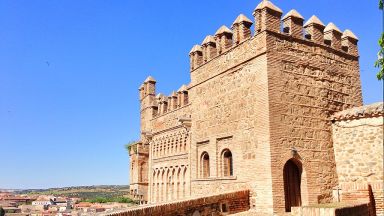
The Puerta del sol was built by the Hospitaller Knights as a gateway to the walled city in the 13th century.
It has a rectangular floor plan which finishes in a semi-circle. The entrance, with a horseshoe arch, is flanked by two towers. At the centre of the blind arches there are remains of an early Christian sarcophagus from the 4th century. It features a relief with the emblem of the cathedral that represents the imposition of the chasuble to San Idelfonso under the Sun and the Moon, hence the name of the door.
Location: Puerta del Sol, Callejón San José, Toledo, Spain
Read more about Puerta del sol (Toledo)
3. Mezquita del Cristo de la Luz
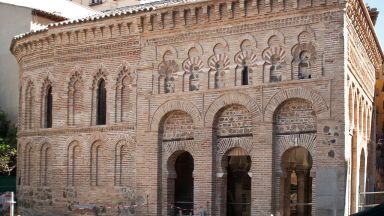
The Mosque of Cristo de la Luz is a former mosque in Toledo, Spain. It is the one of the ten that existed in the city during the Moorish period. The edifice was then known as Mezquita Bab-al-Mardum, deriving its name from the city gate Bab al-Mardum. It is located near the Puerta del Sol, in an area of the city once called Medina where wealthy Muslims used to live.
Location: Ermita "Mezquita" del Cristo de la Luz C. Cristo de la Luz, 22 45002 Toledo Spain | Hours: 10am-2pm & 3.30-5.45pm Mon-Fri, 10am-5.45pm Sat & Sun | Price: adult/child €2.80/free
Read more about Mezquita del Cristo de la Luz
4. Termas Romanas
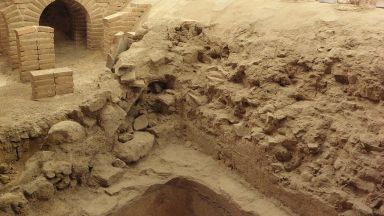
Quick to get around and on the positive side, free to access. The Roman baths, discovered in 1986, are viewed via a walkway extending over two rooms. There are also the remains of an ajibe (water system) dating from the 8th century Moorish era when a large villa stood here.
Location: Termas Romanas, Plaza Amador de los Ríos, Toledo, Spain | Hours: 10am-2pm & 5-9pm Tue-Sat Jun-Sep, 10am-2pm & 4-8pm Tue-Sat Oct-May, 10am-2pm Sun year-round
Read more about Termas Romanas
5. Cuevas de Hércules
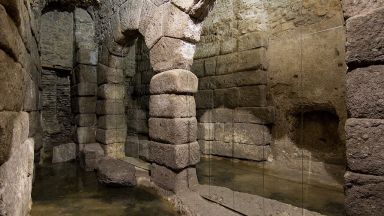
Historic archeological site featuring a Roman-era storage facility in subterranean vaulted caverns.
Location: Cuevas de Hércules, Callejón San Ginés, Toledo, Spain
Read more about Cave of Hercules
6. Plaza de Zocodover
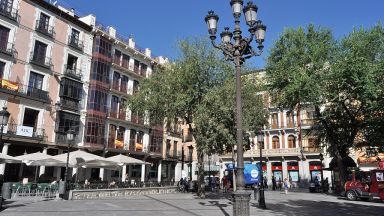
The Plaza de Zocodover is a square of the city of Toledo, in the autonomous community of Castile-La Mancha, Spain. It was the nerve centre of the city during most of its history, acting as its main square. A part of it was designed by Juan de Herrera during the reign of Philip II. Here horses, donkeys, foals, mares, mules and other beasts were sold, when the city of Toledo was Spanish-Muslim city.
Here the most important market of the city took place. It has been celebrated as a weekly market for centuries. Today it occurs on Tuesdays in the vicinity of Paseo de Merchán or de la Vega.
Read more about Plaza de Zocodover
7. Museo De Santa Cruz
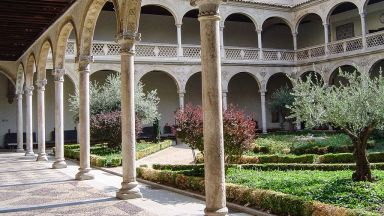
Museo De Santa Cruz is a must visit in Toledo for being one of the most important museums in Spain due to the quality and quantity of pieces it contains, such as archaeological, fine arts and decorative arts.
There are three important collections: Roman, Visigoth, Arabic and Mudejar archaeology; Toledan painting from 16thand 17th centuries with El Greco’s art works; industrial arts with examples of popular culture and artisan local tradition.
Established by Cardinal Mendoza, it is a special building for being a hospital which carries out the new ideas about the importance of the cleanliness, the air circulation and the sunlight. It still has medieval features and shows the evolution towards the Plateresque Renaissance. must visit in Toledo for being one of the most important museums in Spain due to the quality and quantity of pieces it contains, such as archaeological, fine arts and decorative arts.
Location: Museo de Santa Cruz, Calle Miguel de Cervantes, Toledo, Spain
Read more about Museo De Santa Cruz
8. El Alcazar
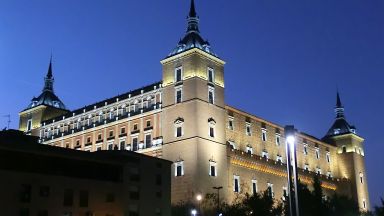
It is today the site of the city’s Army Museum. Its construction dates from Roman times. During the reigns of Alfonso VI and Alfonso X ‘the Wise’ it was rebuilt and became the first example of a square fortress with towers on the corners.
It was once again rebuilt under Emperor Charles V, on this occasion by the architect Alonso de Covarrubias. The façades are Renaissance in style, and it has towers and crenellated defences according to a preliminary design by Alonso de Covarrubias, subsequently completed by Juan de Herrera. After the last reconstruction it became the site of the Army offices and museum.
Location: Alcázar de Toledo C. de la Union, s/n 45001 Toledo Spain | Hours: 10am-5pm Tue-Sun | Price: adult/child €5/free, Sun free | Website
Read more about El Alcazar
9. Santa Iglesia Catedral
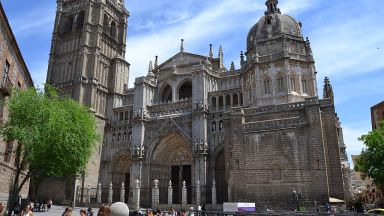
The temple dates back many centuries, but has only existed as a Christian church since the nineteenth century.
The temple was actually built on top of a Muslim mosque, and before that it had been a church in the sixth century during the reign of the Visigoth King Recaredo. King San Fernando and the archbishop began building the new church in 1226. The fifteen chapels of the ambulatory were subsequently completed. In the year 1300 the transept nave was completed, although work continued on the church for the next two centuries.
Location: Santa Iglesia Catedral Primada de Toledo, Calle Cardenal Cisneros, Toledo, Spain | Hours: 10am-6.30pm Mon-Sat, 2-6.30pm Su | Price: €10, incl Torre de las Campanas €12.50 | Website
Read more about Santa Iglesia Catedral Primada De Toledo
10. Baños de Tenerías
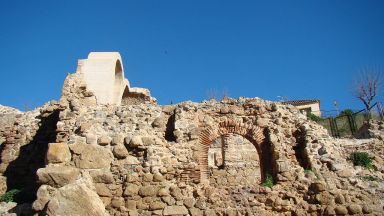
At present it is thought that the archaeological remains found about fifty meters from the church of San Sebastián, in the lower area of the Barrio de Curtidores de Toledo, a few meters from the banks of the Tagus River in its southern sections, belong to one of the of the six Arab baths that the city had.
Indeed, it is thought that these Arab baths known as Baños de Tenerías or San Sebastián de Suso offered the possibility of carrying out purification baths for access to the Al-Dabbagin Mosque (the current church of San Sebastián).
Location: Restos Arqueológico Baños Árabes de Tenerías, Calle Carreras San Sebastián, Toledo, Spain
Read more about Baños de Tenerías
11. Casa y Museo del Greco
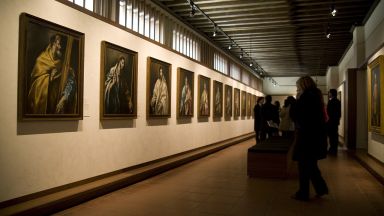
This museum has an extensive collection of paintings by this artist of the Spanish Golden Age.
Opened in 1911, the museum is located in Toledo’s Jewish Quarter. It consists of two buildings: a 16th-century house with a courtyard, and an extension dating from the early 20th century. The two share a garden. The museum houses numerous works by El Greco, especially from this brilliant painter’s last period, as well as canvases by other 17th century Spanish painters, furniture from the same era and pottery from Talavera de la Reina.
Location: El Greco Museum, Paseo Tránsito, s/n, 45002 Toledo, Castilla-La Mancha, Spain | Hours: 9.30am-7.30pm Tue-Sat Mar-Oct, to 6pm Nov-Feb, 10am-3pm Sun year-round | Price: adult/child €3/1.50, from 2pm Sat & all day Sun free | Website
Read more about Museo del Greco
12. Synagogue of El Transito
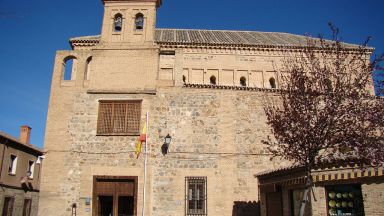
Mudéjar art in El Tránsito synagogue. The El Tránsito synagogue is the common name for the synagogue of Samuel ha-Leví, and is the most important example of Spanish-Jewish art in existence. It was built in the 14th century, and is decorated with Mudéjar elements and beautiful geometric and floral motifs, and inscriptions in Arabic and Hebrew.
Location: Sephardic Museum C. Samuel Levi, 2 45002 Toledo Spain | Hours: 9.30am-7.30pm Tue-Sat Mar-Oct, to 6pm Tue-Sat Nov-Feb, 10am-3pm Sun year-round | Price: adult/child €3/1.50, after 2pm Sat & all day Sun free | Website
Read more about Synagogue of El Transito
13. Iglesia de Santo Tomé
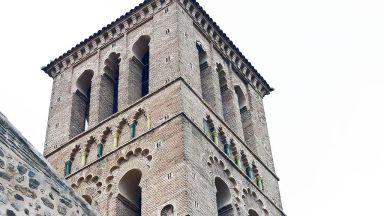
The church itself, which dates back to the 12th Century is relatively small and is located on the site of an old mosque. In fact, the gorgeous squared tower was the old minaret that was converted to a bell tower.
The main draw for the church today is to view The Burial of the Count of Orgaz. The church also houses El Greco’s masterpiece, El Entierro del Conde de Orgaz, also known as The Burial of the Count of Orgaz. The painting itself is huge and the very vivid colours portray a death on the earthly plane and an image of heaven above. There is much to see in this painting, but not enough time in the St. Tome Church.
Location: Iglesia de Santo Tomé Pl. del Conde, 4 45002 Toledo Spain
Read more about Iglesia de Santo Tomé
14. Monasterio de San Juan de los Reyes
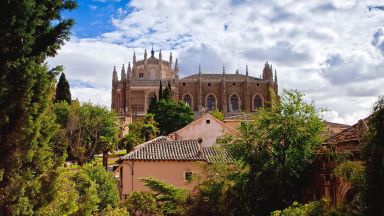
The Monasterio de San Juan de los Reyes was built to commemorate the victory at the Battle of Toro and commissioned by the Catholic Monarchs.
It has a single nave, with side chapels located between the buttresses. Of particular interest on the main façade are the chains of the freed prisoners. It has a late Gothic cloister and the ceiling on the second floor is in the Mudéjar style. Its church has a single nave with a stellar vault. Another highlight is the main chapel, which is decorated with the coats of arms of the Catholic Monarchs supported by a large eagles, ogee arches and the figures of saints.
Location: Monasterio de San Juan de los Reyes, Calle de los Reyes Católicos, Toledo, Spain | Hours: 10am-6.45pm Mar-Oct, to 5.45pm Nov-Feb | Price: €3 | Website
Read more about Monasterio San Juan de Los Reyes
15. San Martin's Bridge
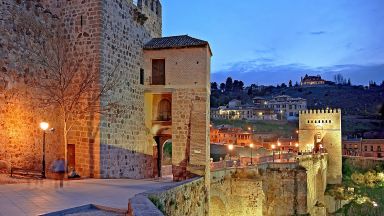
San Martin’s Bridge has one of the most beautiful sunsets in Spain. The bridge was built in the Middle Ages and dates to around the 13th century, the bridge was later rebuilt almost entirely.
Initially it was constructed from ashlars. It was later modified with new defensive structures such as the two end towers, one from the 13th century and the other connecting to the wall from the 16th century. All this has meant that today the bridge has an impeccable structure. In 1921 it was declared a National Monument. It has five arches.
Location: San Martin's Bridge Bajada San Martín 45004 Toledo Spain
Read more about Puente de San Martín (Toledo)
16. Puerta Del Cambrón
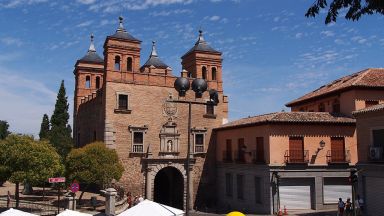
The Puerta Del Cambrón was also historically known as the gate of the Jews. This gate owes its name to the spiny buckthorn bushes all around it which are known in Spanish as cambroneras.
The Puerta Del Cambrón was built over the remains of a Visigoth gate, and the current structure is in the Renaissance style with a square floor plan. On the interior façade there is a statue of Santa Leocadia attributed to Berruguete.
Location: Puerta Del Cambrón, Puerta del Cambrón, Toledo, Spain
Read more about Puerta Del Cambrón
This website uses affiliate links which earn a small commission at no additional cost to you.
